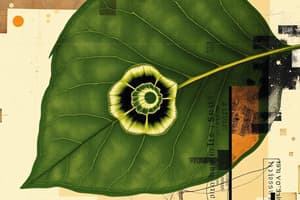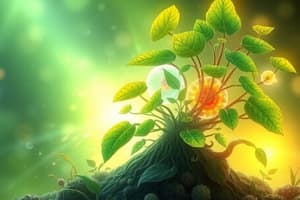Podcast
Questions and Answers
What is the primary structural feature of stomata in the epidermis of leaves that aids in gas transport?
What is the primary structural feature of stomata in the epidermis of leaves that aids in gas transport?
- Multiple layers of epidermal cells
- Xylem and phloem arrangement
- Guard cells that open and close (correct)
- Thick cuticle layer
All aquatic vertebrates possess specialized gas exchange structures.
All aquatic vertebrates possess specialized gas exchange structures.
False (B)
Name one benefit of having a long and thin body shape in certain invertebrates for gas exchange.
Name one benefit of having a long and thin body shape in certain invertebrates for gas exchange.
Increased surface area for gas exchange
In larger, more active species, specialized gas exchange structures have _____ based on habitat and lifestyle.
In larger, more active species, specialized gas exchange structures have _____ based on habitat and lifestyle.
Match the following organisms with their gas exchange adaptations:
Match the following organisms with their gas exchange adaptations:
Which of the following structures is primarily responsible for regulating gas exchange in plants?
Which of the following structures is primarily responsible for regulating gas exchange in plants?
Fungi obtain nutrients through photosynthesis.
Fungi obtain nutrients through photosynthesis.
What is one physiological mechanism that allows plants to adjust their gas exchange rates?
What is one physiological mechanism that allows plants to adjust their gas exchange rates?
The large surface area to volume ratio in mycelium helps fungi effectively exchange gasses through __________.
The large surface area to volume ratio in mycelium helps fungi effectively exchange gasses through __________.
Match the following gas exchange mechanisms with their organisms:
Match the following gas exchange mechanisms with their organisms:
What is one advantage of aerobic respiration compared to anaerobic respiration?
What is one advantage of aerobic respiration compared to anaerobic respiration?
Anaerobic respiration has been shown to allow for the evolution of larger organisms.
Anaerobic respiration has been shown to allow for the evolution of larger organisms.
What are the main structures responsible for gas exchange in plants?
What are the main structures responsible for gas exchange in plants?
The process by which organisms exchange gases with their environment is called __________.
The process by which organisms exchange gases with their environment is called __________.
Match the organisms with their respective gas exchange systems:
Match the organisms with their respective gas exchange systems:
Which feature of gas exchange surfaces helps to maximize diffusion according to Fick's Law?
Which feature of gas exchange surfaces helps to maximize diffusion according to Fick's Law?
Fick's Law states that the rate of diffusion is directly proportional to the membrane thickness.
Fick's Law states that the rate of diffusion is directly proportional to the membrane thickness.
Name one feature of gas exchange surfaces in animals that aids in oxygen absorption.
Name one feature of gas exchange surfaces in animals that aids in oxygen absorption.
Flashcards are hidden until you start studying
Study Notes
Leaf Structure & Gas Transport
- Epidermis is the outer layer of a leaf and contains stomata which are pores that allow for gas exchange.
- Stomata are surrounded by guard cells, which control their opening and closing.
- Mesophyll is the internal tissue of a leaf containing chloroplasts where photosynthesis occurs.
- Vascular tissue (xylem and phloem) transports water and nutrients throughout the plant.
- Xylem transports water up the plant from the roots to the leaves, bringing water for photosynthesis.
- Phloem transports sugars and other products of photosynthesis from leaves to other parts of the plant.
- Gases like carbon dioxide and oxygen move between the atmosphere and the plant through stomata.
- Guard cells swell in response to changes in turgor pressure to open and close the stomata for gas exchange.
Gas Exchange Systems in Animals
- Thin tissues of moist and aquatic animals allow for gas exchange by simple diffusion across their body wall.
- Annelids, nematodes, and platyhelminthes increase surface area for gas exchange with long thin bodies and specialized structures (like parapodia or feeding tentacles).
- Larger, more active animals have evolved specialized gas exchange structures like gills or lungs.
- Gill structures are typically found in aquatic animals and function to extract dissolved oxygen from water.
- Lungs are found in terrestrial animals and function to obtain oxygen from the air.
- Body movement or respiratory structures create pressure gradients to optimize the rate of diffusion across the gas exchange surfaces.
Advantages of Aerobic Respiration
- Aerobic Respiration releases more ATP (32–38) compared to anaerobic respiration (2 ATP).
- This increased ATP production may have allowed for the evolution of multicellularity and larger organism sizes.
Features Maximizing Diffusion
- Gas exchange surfaces must maximize membrane area and minimize membrane thickness to meet the organism's oxygen requirements.
- Branching or folded membranes increase surface area for diffusion.
Plant Gas Exchange Adjustment
- Different plant species have unique stomata shapes (kidney-shaped vs dumbbell-shaped) affecting their opening and closing.
- This difference allows plants to adjust their rates of gas exchange according to environmental conditions.
High Surface Area to Volume Ratios in Fungi
- Fungi's large mycelium with microscopic hyphae increases their surface area to volume ratios and aids in gas exchange.
- Mycelium extends into small crevices of soil and substrates, interacting with air pockets.
- Fruiting bodies are produced by fungal colonies and exchange gas through their thin, porous body walls.
Leaf Cell/Tissue Label and Gas Movement Path
- Epidermis: Outer layer of leaf
- Mesophyll: Internal tissue of the leaf containing chloroplasts
- Vascular tissue: Xylem and phloem, transport water and nutrients
- Stomata: Openings on the leaf surface for gas exchange
- Guard cells: Surround stomata and control their opening and closing
- Carbon dioxide enters the leaf through the stomata and is used in photosynthesis.
- Oxygen produced during photosynthesis exits the leaf through the stomata.
- Water is absorbed by the roots and transported to the leaves through the xylem.
- Sugars produced during photosynthesis are transported to other parts of the plant through the phloem.
Studying That Suits You
Use AI to generate personalized quizzes and flashcards to suit your learning preferences.




